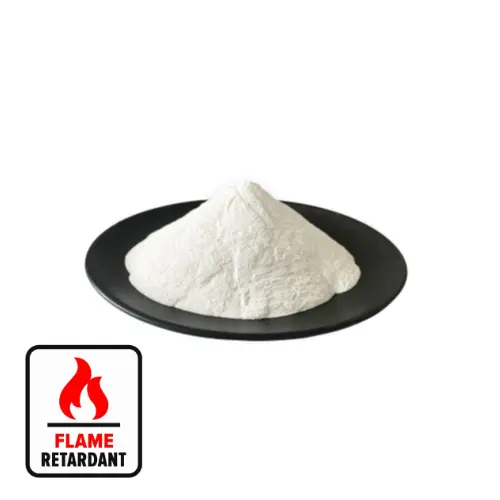Mit der zunehmenden Verbreitung brennbarer Polymermaterialien ist auch der Bedarf an Flammschutzmitteln stark gestiegen.
Im Vergleich zu organischen Flammschutzmitteln haben anorganische Flammschutzmittel die Vorteile niedriger Produktionskosten, hoher Flammschutzwirkung und geringer Umweltverschmutzung usw. Anorganische Flammschutzmittel sind jedoch schlecht mit Polymermaterialien kompatibel, haben einen großen Einfluss auf die mechanischen Eigenschaften von Materialien und müssen normalerweise modifiziert werden, um eine bessere Flammschutzwirkung zu erzielen. Daher ist die Suche nach einer wirksamen Verbesserung der Kompatibilität von Flammschutzmitteln und die Förderung guter Modifizierungsmethoden die notwendige Forschung für die Entwicklung anorganischer Flammschutzmittel.
Die wichtigsten Arten anorganischer Flammschutzmittel sind gegenwärtig Aluminiumhydroxid, Magnesiumhydroxid, anorganische Phosphorverbindungen, Borate, Antimonoxid, Molybdänverbindungen usw. Die am besten erforschten Methoden zur Flammschutzmodifizierung von Magnesiumhydroxid sind die flammhemmende Mikroverkapselung, die ultrafeine Flammschutzmittelmodifizierung und die flammhemmende Oberflächenmodifizierung.
I. Mikroverkapselung von Flammschutzmitteln Magnesiumhydroxid
Bei der Mikroverkapselungstechnologie werden feste, gasförmige oder flüssige Polymermaterialien in winzige Kapseln mit einer Hülle und einem Kern von 1 μm bis 5000 μm Durchmesser eingewickelt. Die Merkmale der Mikroverkapselungstechnologie bestehen darin, dass Mikrokapseln Flüssigkeiten und Gase morphologisch in Feststoffe umwandeln können, wodurch das Kernmaterial neue physikalische Eigenschaften erhält. Die Kapselwand kann eine isolierende und schützende Rolle spielen und ermöglicht die stabile Koexistenz von Substanzen, die leicht miteinander reagieren können, während farbige, schmackhafte oder giftige Substanzen abgeschirmt werden. Das Kernmaterial kann nach Bedarf kontrolliert freigesetzt werden.
Zu den wichtigsten Herstellungsverfahren für flammhemmende Mikrokapseln gehören Grenzflächenpolymerisation, In-situ-Polymerisation, Phasentrennung, Lösungsverdampfung, Sol-Gel-Verfahren usw.
2. Flammschutzmittel ultrafein
Ein nanoskaliger Flammschutz ist ein Block-, Film-, Mehrschichtfilm- und faserartiger Flammschutz, der aus ultramikroflacher Flammschutzpartikel mit einer Partikelgröße von 1 nm bis 100 nm zusammengesetzt ist. Nach der Behandlung herkömmlicher anorganischer Flammschutzmaterialien durch Hyperfeinung werden der Größeneffekt und der Oberflächeneffekt von Nanopartikeln genutzt, um den Grenzflächeneffekt zu verstärken, sodass der Flammschutz gleichmäßiger im Matrixharz verteilt werden kann und die Rolle der Plastifizierung und Verstärkung starrer Partikel spielen kann, wodurch die Kompatibilität von Flammschutzmittel und Polymermatrix verbessert wird und die Schlagfestigkeit und Flammschutzleistung des Materials verbessert werden.
In den letzten Jahren haben Wissenschaftler die Modifizierung von flammhemmenden Ultrafeinstoffen anhand traditioneller Methoden der Gasphasenherstellung, Flüssigphasenherstellung und hochenergetischer mechanischer Kugelmahlmethoden untersucht. Dabei wurden immer mehr Methoden zur Modifizierung von flammhemmenden Ultrafeinstoffen erforscht und erfunden.
Aufgrund der hohen Flammschutzwirkung des Nano-Flammschutzsystems sowie seiner Ungiftigkeit und Umweltverträglichkeit ist seine Verbindung und Synergie mit anderen Flammschutzmitteln zu einem der wichtigsten Themen der Nano-Flammschutzmittel geworden.
3. Oberflächenmodifizierung von Flammschutzmitteln Magnesiumhydroxid
Oberflächenmodifizierung ist die Verwendung physikalischer oder chemischer Methoden, die Verwendung von Oberflächenmodifikatoren auf der Oberfläche der Partikel, chemische Reaktion und Oberflächenbeschichtung, um die chemischen und physikalischen Eigenschaften des Partikeloberflächenprozesses zu ändern. Es gibt viele Methoden zur flammhemmenden Oberflächenmodifizierung, die in Bezug auf den Modifikator in Kopplungsmittelmodifizierung und organische Modifizierung sowie in Trocken- und Nassverfahren unterteilt werden können.
Ein Haftvermittler ist ein typischer Modifikator. Seine Moleküle enthalten hydrophile und hydrophobe Gruppen. Hydrophile Gruppen reagieren chemisch mit der Oberfläche von anorganischem Pulver und überziehen die Oberfläche von anorganischem Pulver mit einer Schicht aus organischem Film. Dadurch wird die Oberflächenenergie des anorganischen Pulvers verringert und seine hydrophilen Oberflächeneigenschaften verändert. Hydrophobe Gruppen können mit Polymermaterialien reagieren oder sich verhaken. Sie fungieren als Brücken zwischen anorganischem Pulver und Polymermaterialien, sodass das anorganische Pulver fest mit dem Polymer verbunden wird.
Gängige Kupplungsmittel sind Silankupplungsmittel, Aluminatkupplungsmittel und Titanatkupplungsmittel.
Zusammenfassung
Gegenwärtig sind Flammschutzmittel bei der Verwendung von Kunststoffzusätzen auf den zweiten Platz gerückt. Obwohl immer noch neue Arten anorganischer Flammschutzmittel wie Zinnverbindungen, Schlüsselverbindungen, Eisenverbindungen, expandierter Graphit usw. entwickelt werden und einige Entwicklungen stattgefunden haben, liegt der Schwerpunkt der Arbeiten für einige Zeit in der Zukunft noch immer auf der Modifizierung von anorganischen Flammschutzmitteln aus Aluminiumhydroxid und Magnesiumhydroxid und anderen Metallhydroxiden, mit der Compoundierung als Schwerpunkt, und der ständigen Verbesserung ihrer Auswirkungen auf die physikalischen und mechanischen Eigenschaften des Materials, insbesondere der Entwicklung hocheffizienter Synergisten, und der Förderung der Entwicklung anorganischer Flammschutzmittel in Richtung hoher Effizienz und Funktionalisierung.

